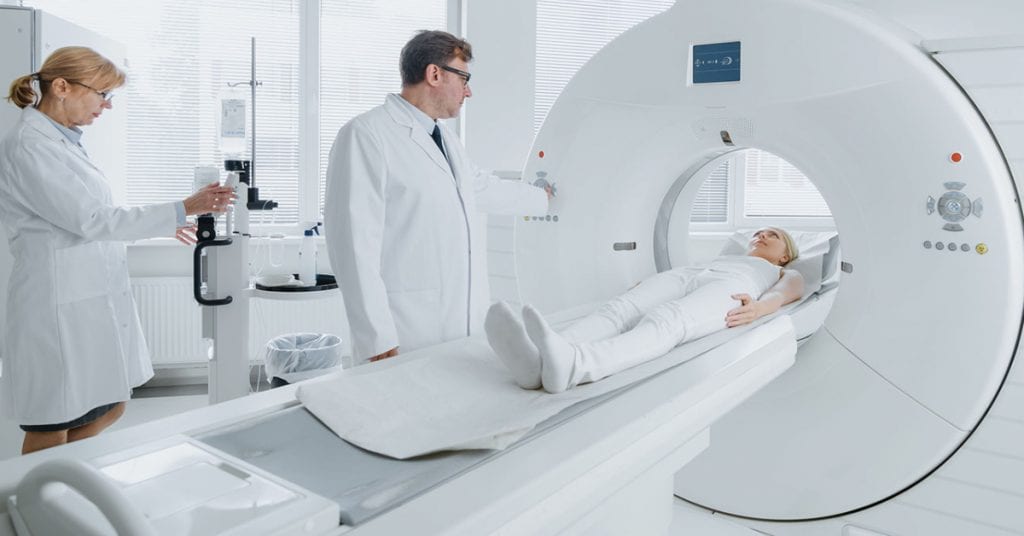Cost of Contrast MRI with Gadolineo (any region) in India
| Treatment | Cost | Days in hospital | Days outside hospital | Total stay in India |
|---|---|---|---|---|
| Contrast MRI with Gadolineo (any region) | USD 225 | OPD | NA | 1 |
MRI
Magnetic Resonance Imaging (MRI) is a painless and non-invasive procedure, which uses a magnetic field, along with computer-generated radio waves for creating detailed images of the organs, as well as tissues in the body. This procedure is done using MRI machines, which are large, tube-shaped magnets. When a person lies inside the machine, the magnetic field realigns water molecules in the body. The aligned atoms are made to produce faint signals with the help of radio signals, which are used for creating cross-sectional MRI images, such as slices in a loaf of bread. An MRI scan differs from a CT scan or an X-ray scan as it doesn’t use radiation for producing images.
Why is it done?
An MRI is a non-invasive way for your doctor to examine your organs, tissues as well as skeletal system. It can produce high-resolution images of the inside of the body, which can help in diagnosing a variety of problems like:
- Aneurysms, or bulging in the blood vessels of the brain
- Spinal cord injuries
- Multiple sclerosis
- Stroke
- Infections
- Tumors
- Cysts
- Swelling
- Hormonal disorders, like acromegaly and Cushing’s syndrome
- Inflammation
- Problems with the development of structure
- Blood vessel issue
- Problems due to a previous head injury
A head MRI helps in determining whether you had sustained any kind of damage from a stroke or head injury. A head MRI might also be used to investigate other symptoms like dizziness, weakness, blurry vision, seizures, changes in behavior or chronic headaches. Such symptoms might be caused by a brain issue, which an MRI scan can help in detecting.
A functional MRI, known as fMRI of the brain helps people who might have to undergo brain surgery. An fMRI can also help in pinpointing areas of the brain which are responsible for speech and language as well as body movement. It measures metabolic changes taking place in the brain when you perform certain tasks. During the test, you might need to carry out small tasks, like answering basic questions or tapping your thumb with your fingertips.
There is another type of MRI which is called magnetic resonance angiography, which is used for examining the blood vessels in the brain.
Preparation
Procedure
First, you will lie down on a movable table which will slide down into the opening of the tube of the MRI machine. A technologist will be monitoring you from another room, with whom you can talk with a microphone.
If you suffer from claustrophobia, which is fear of enclosed spaces, you might be given a drug that will decrease your anxiety, by making you feel sleepy. Most people can get through the exam without any kind of difficulty.
Next, the MRI machine creates a strong magnetic field around your body and radio waves are then directed at your body. This is a painless procedure. You won’t feel the magnetic field or radio waves, as there are no moving parts around you.
During the MRI scan, the internal part of your magnet produces repetitive tapping, thumping as well as other noises. They might be giving you earplugs or have music playing to block the noise.
In some cases, a contrast material which is typically gadolinium, will be injected through an intravenous line into a vein in your hand or arm. The contrast material enhances certain details. Though Gadolinium is known to cause allergic reactions, it is very rare.
An MRI can take anywhere between 15 minutes to over an hour. During the procedure, you will need to hold still as movement can blur the resulting images.
During a functional MRI, they might ask you to perform a few small tasks, such as tapping your thumb against the other fingers or answering simple questions. This can help in pinpoint the portions of your brain which controls these actions.
After the Test
If you were not sedated, you can return to the usual routine, right after the scan.
The images of your scan will be analyzed by a doctor who is trained to interpret MRIs. After this, the reports will be given to your doctor, after which he will continue the next steps with you.
Risks
Since MRI uses powerful magnets, the presence of metal in your body might be a safety hazard if they are attracted to the magnet. Even if not attracted to the magnet, the MRI images can be distorted due to metal objects. Before having an MRI, you might be required to go through a questionnaire that includes questions regarding whether you have metal or electronic devices in your body. You will not be able to have an MRI if the devices in your body are not safe for MRI.
If you have tattoos or permanent makeup, it is important to discuss with your doctor, whether they will affect the MRI scan, as some of the darker inks might contain metal.
Before you schedule your MRI, inform your doctor if you might be pregnant. If this is the case, the MRI might need to be postponed. If you having kidney or liver problems, it is important to discuss these with your doctor.



